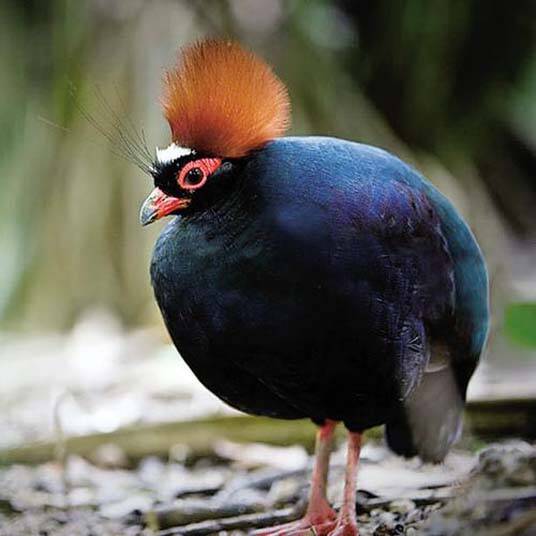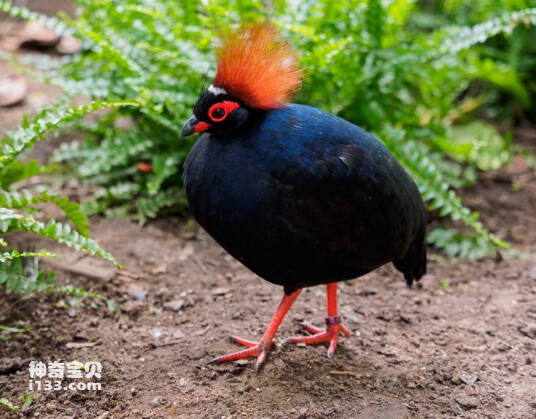Rollulus roulroul
IUCN
LCBasic Information
Scientific classification
- name:Rollulus roulroul
- Scientific Name:Rollulus roulroul,Crested Partridge,Perdiz Rulrul
- Outline:Landfowl
- Family:Chickeniformes P.family C.Partridge
Vital signs
- length:About 26 cm
- Weight:225-300g
- lifetime:8-12years
Feature
The whole is bluish-purple with a glossy color, and the head has a cluster of gorgeous bright red feathers
Distribution and Habitat
It is distributed in Myanmar, Thailand, Malaysia, Brunei, Indonesia, Kalimantan and Sumatra, and it lives across the island countries of Southeast Asia.
It lives in broad-leaved evergreen and dense primary lowland and mountain forests and bamboo forests up to 1,550 meters high. Mainly inhabits in the low mountains and hilly areas of scrub, grassland, rock slopes and other forest-free barren mountain areas.
Appearance
The coronal partridge is 26 cm long, the male weighs about 240-300 grams, and the female weighs about 225-275 grams. The whole is bluish-purple with luster, and the legs are red; Male and female are quite different from other pheasants, both sexes have red eye circles, long slender whiskers near the beak, and both have beautiful plumage. The male is a lustrous bluish-purple color with a pale green back and a cluster of bright red feathers on the head. Although the coronal partridge is similar in size to quail, its crest is very characteristic, and a handful of red silk-like fluff on the male bird's head is burning like a torch, which is very beautiful and eye-catching, and it is also quite distinctive in pheasants. The female is green except for the reddish-brown wings and has long, slender whiskers near the beak.
The mouth is short and strong, the tip of the upper mouth slightly curved downward, but not hooked; The nostrils were not concealed by feathers. Wings slightly rounde
Details
The coronal Partridge (scientific name: Rollulus rouloul) Crested Partridge in English, Perdiz Rulrul in Spanish, no subspecies.

Coronal partridges tend to live alone or in pairs, sometimes in small groups of up to 15 individuals. Prefers to live in dry areas, descending to the valleys in the early morning and late afternoon to hunt for food. It lives in the grass at night. It is active on dry brown dew rock slopes.
It mainly eats seeds, beetles, ants, snails, etc. It also eats vegetables such as corn, peas, broccoli, carrots, zucchini, sweet potatoes, etc. This bird prefers fruits, such as apples, pears, grapes, blueberries, plums, bananas, papayas, kiwis and oranges, which are too small to eat these fruits. So coronal partridges usually pick up leftovers from herbivores like wild boars and tapirs.

Coronal partridges can mate and breed at any time of the year. The marriage is monogamous. The male makes a simple nest in the ground with dead grasses. The female lays five to six eggs at a time, and up to eight eggs in captivity. After two weeks, it begins to grow gorgeous feathers, and after about three months, it can grow the same as the adult bird, and it is sexually mature at about 1 year old, and can live for 8-12 years.
The Sundaic lowlands of Indonesia and Malaysia have suffered extensive forest destruction (Kalimantan lost nearly 25% of its evergreen forest between 1985 and 1997, and Sumatra lost nearly 30% in 1985) due to a combination of shrinking habitat ranges, logging, and land conversion. Coupled with the bushfires (especially in 1997-1998) and the plight of the caged bird trade, the situation was further worsened. However, the species' use of secondary forests and higher elevations means they are not immediately threatened.
Listed on the IUCN Red List of Threatened Species (IUCN) for 2021 ver 3.1 - Vulnerable (VU).
Protect wild animals and eliminate wild meat.
Maintaining ecological balance is everyone's responsibility!








